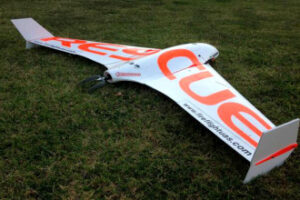Most of what was learned at this year’s Black Dart counter-drone exercise will remain classified, but it proved that one of the oldest and deadliest weapons in the U.S. arsenal works against the 21st Century threat of drones, too.
“The Marine sniper shot from a UH-1Y Huey,” Lt. Cdr. Ryan Leary, a Black Dart project officer for the Joint Integrated Air and Missile Defense Organization (JIAMDO), said. This was the first recorded instance of an airborne Marine sniper taking out a drone with a rifle, he added.
That was one of 20 “kinetic and non-kinetic engagements” against “surrogate threat drones” conducted during the July 27-Aug. 6 Black Dart exercise on Point Mugu range at Naval Base Ventura County, Calif.
Leary offered no details on how the Marine sniper in the Huey killed a surrogate threat Flanker, a flying-wing drone with a seven-foot span and one of the smallest surrogate threats used at this year’s Black Dart. A Navy MH-60S Knighthawk helicopter crew firing a 20mm cannon also knocked down a Flanker, Leary said. “Even though it doesn’t seem on the latest cutting edge technology that we’re using a machine gun on the side of a helicopter, it’s still a proof of concept,” Leary said.
This year’s focus was on small drones of the sort now plaguing airline pilots and posing a larger and larger worry for military commanders, law enforcement, the Secret Service, and the Department of Energy. In the past year alone, a drunk intelligence analyst landed a small drone on the White House lawn; drones of unknown origin were spotted over nuclear reactors in France; and a protester landed a small drone carrying radioactive material on the roof of the Japanese prime minister’s residence.
Armed helicopters have knocked out surrogate threat drones at previous editions of Black Dart, a formerly classified exercise conducted annually since 2002, using a .50-caliber machine gun and a modified AGM-114 Hellfire missile. But those kills came against a much larger drone called the Outlaw, a conventional airplane UAS whose wingspan is 13.5 feet.
About 650 people from government, academia and industry took part in this year’s exercise, Leary said, testing several dozen systems against a range of surrogate threat drones.
This year’s Black Dart included surrogate threat drones from the smallest of five categories the military uses to classify drones. “There were a lot of systems that we had there that were focusing on new and improved ways to detect them, and then also new and improved ways to discriminate them” from birds and other objects. Jamming and other forms of electronic warfare are clearly part of the equation, too, but they are classified to keep adversaries from figuring out counter moves.
“We usually tried to keep multiple UASes in the air at one time,” he said. “We would have a window of the day where we’d take off and fly these aircraft. For several hours after launch, we’d have these systems up flying around various profiles. To keep the scenario tactically relevant, even though they were taking off from the runway, we would change when they were taking off and then we would also change flight profiles. So sometimes they might fly out to sea and then come back in towards the beach. We didn’t just repeat the same thing every single day. There was a lot of variety, flying different elevations, flying different flight paths, different geographies, so that at the end we have a pretty comprehensive assessment of how well radar systems and tracking systems were able to detect and maintain track of these UASes.”
An internal JIAMDO report will take months to complete, Leary said, but one thing is crystal clear. “We didn’t solve the problem in 2015,” he confirmed with good humor, “so we will continue our efforts.”
Navy jet trainer fleet operations remain paused after engine mishap
One week after the incident, a Navy spokesperson says the service is continuing to assess the fleet’s ability to safely resume flight.



























